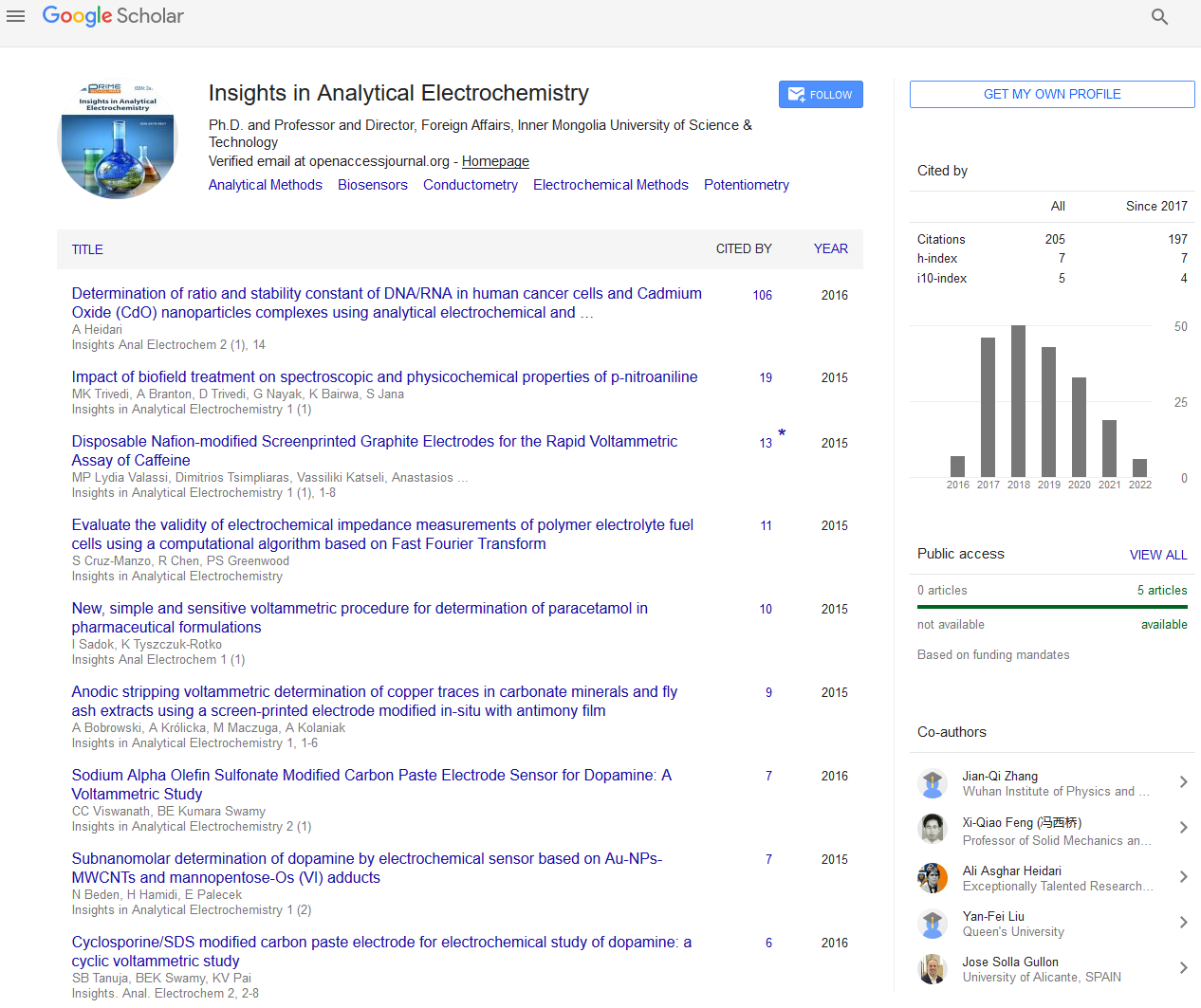Keywords
Electrodeposition; Ni-W-rGO composite coating; HER; SEM; XRD study
Introduction
Hydrogen is widely accepted as the green alternative to the fossil fuel [1-3]. However, the major portion of worldwide hydrogen production is still dependent on the hydrocarbon sources leading to the emission of huge amount of greenhouse gases [2,3]. The production of H2 from such hydrocarbon sources is neither environmentally benign nor sustainable in the long run [1]. In this context, water splitting has been emerged as an ideal method for the production of high purity H2 [1-6]. Water electrolysis is a pollution free simple process utilizing the abundant and cheaply available water as the feedstock [2-4]. Whereas, the high energy consumption (overvoltage) for water splitting impedes its wide application [3]. Activation polarization, the major reason for the high overvoltage can be controlled by the selection of good electrode materials [4-6]. The development of noble metal free electrode materials for electrocatalytic hydrogen evolution reaction (HER) is a great challenge to make water electrolysis economically more viable [3-6]. In this regard, Ni based alloys and its composites are attractive due to their intrinsic catalytic activity and cost effectiveness [3-6]. Hence, the alloying Ni with hard and high melting transition metal, namely W can offer better corrosion resistance and electro catalytic efficiency for alkaline water electrolysis.
Composite coatings are found to be a very auspicious and briskly developing field of great importance, both in research and practical applications [7-10]. The rigorous development of the composite coating technology allows the production of metal matrix coatings with various homogeneously dispersed phases, which can impart synergistic properties of the matrix and the guest material [9,10]. Metal/alloy- graphene composite is one of the most promising composite coatings among this class of materials due to its attractive anticorrosion [8], tribological [11] and electrocatalytic [12,13] properties. Whereas, the poor dispersiveness of graphene due to its low density making it difficult to synthesize a metal/alloy-graphene composite through conventional metallurgical methods [11]. In this regard, electrodeposition becomes an effective technique to produce this type of composite coatings through the electrochemical reduction of water dispersible graphene oxide (GO) [14]. This is considered as one of the most simple and economically feasible methods for the fabrication of functional composite coatings for various application [11,15].
In the present investigation, we are developing Nickel-Tungstenreduced Graphene Oxide (Ni-W-rGO) composite coating as an efficient electrocatalytic material for alkaline HER through the codeposition of homogeneously dispersed GO. The electrocatalytic efficacy of the composite coating is compared with the conventional alloy coating to ensure the improvement after the incorporation of reduced graphene nanosheets into the alloy matrix.
Experimental
The deposition of electroactive Ni-W alloy coatings and their characterization were reported elsewhere [16,17]. Further, graphene oxide (GO) was synthesized using modified Hummer’s method as reported by Su et al. [18] and added to the optimal plating bath to study the effect of GO on coating characteristics. The formation of GO after the chemical treatment of graphite was confirmed using various characterization techniques such as Raman spectroscopy (Bruker Senterra R200), X-ray diffraction (XRD, Rigaku Miniflex 600, with CuKλ radiation as the X-ray source) and transmission electron microscopy (TEM, JEOL, JEM-2100). A small amount GO (0.5 g L-1) was added into the plating for getting it deposited as reduced graphene oxide (rGO) to develop Ni-W-rGO nanocomposite coating. The GO added into the plating bath was dispersed homogeneously through overnight stirring and used directly for deposition on copper rod of 1 cm2 effective surface area. The deposition was performed in a custom made 250 mL glass setup using the pre-cleaned copper rod as cathode and Ni as anode. A schematic of the composite electrodeposition process is shown in Figure 1. The composite coating was developed at an optimal current density of 4.0 A dm-2, as obtained from our earlier study [17]. The alloy and composite depositions were carried out for the same duration of time (600 s), using DC power source (Agilent-N6705A). The developed alloy and composite coatings were characterized by their surface appearance, composition and phase structure using scanning electron microscopy (SEM, JSM-7610F from JEOL, USA), energy dispersive spectroscopy (EDS) and XRD, respectively. The thickness of the alloy and composite coatings was measured using coating thickness gauge (Coatmeasure M and C) and confirmed SEM cross-sectional analysis.
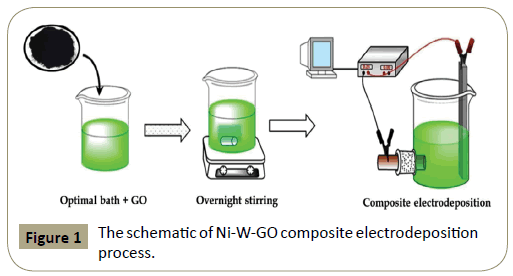
Figure 1: The schematic of Ni-W-GO composite electrodeposition process.
Electrochemical characterization
The electrochemical characterization of the alloy and composite coatings were carried out using a Potentiostat/ Galvanostat, Biologic SP-150 (Biologic Science Instruments, France). The electrocatalytic activity of the coatings towards alkaline HER was studied in a home made water splitting study setup as shown in Figure 2. A three-electrode system with alloy coated substrate as working electrode, platinized platinum of same area as a counter electrode and saturated calomel electrode (SCE) as reference, was made to perform the electrochemical study. Electrochemical analysis such as cyclic voltammetry (CV, recorded within a potential range of 0 to -1.6 V) and chronopotentiometry (CP, recorded for 1800 s by applying a constant current density of -300 mA cm-2) were carried out to examine the stability and activity of the test electrodes in 1.0 M KOH medium.
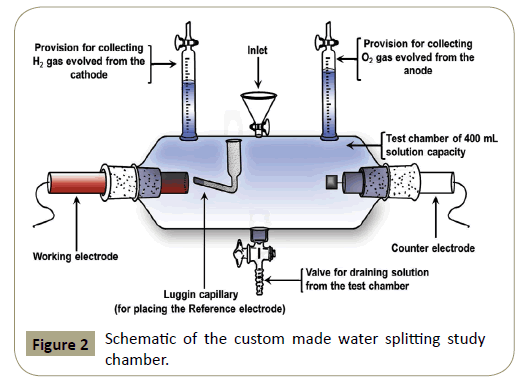
Figure 2: Schematic of the custom made water splitting study chamber.
Results and Discussion
Characterization of graphene oxide
The synthesized GO nanosheets were characterized using various instrumental methods of analysis. The obtained GO was examined using Raman spectroscopy, an invaluable technique to obtain the structure, crystallization and defects of carbon materials [11,18]. The Raman spectra of the obtained GO nanosheets are given in Figure 3. The presence of two peaks at 1318 and 1610 cm-1, characteristics of the D and G bands corresponds to E2g phonon of sp2 C atoms and carbon lattice defects, respectively [11,13,18].
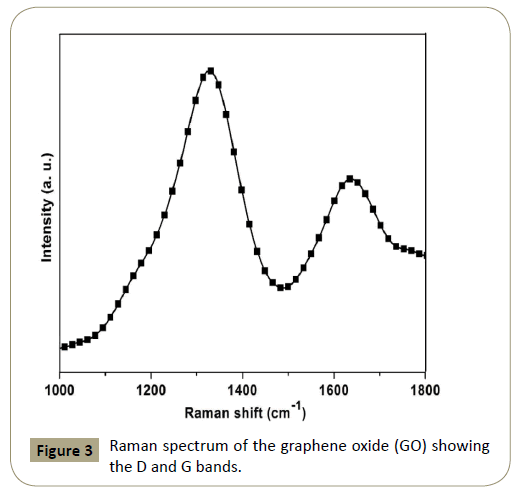
Figure 3: Raman spectrum of the graphene oxide (GO) showing the D and G bands.
The formation of GO is also confirmed by the XRD analysis. Figure 4 shows the XRD pattern obtained for the synthesized GO nanosheets. The absence of characteristics reflection of graphite (2θ=26˚) and the presence of a reflection at 2θ=10.4˚, with d spacing of 0.68 nm, due to the intercalation of oxygen confirms the formation of GO [18-20].
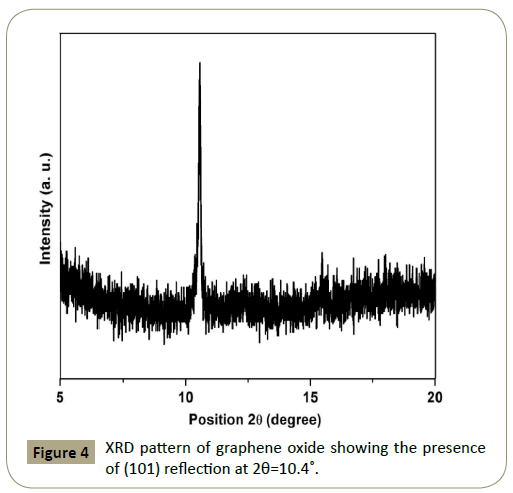
Figure 4: XRD pattern of graphene oxide showing the presence of (101) reflection at 2θ=10.4˚.
Further, the structural characterization of GO nanosheets was performed using TEM analysis (Figure 5). The obtained TEM image clearly depicts the rippled and entangled GO nanosheets. The presence of single nanosheets is also evident from the TEM image as shown in Figure 5. All these characterizations confirm the formation of GO after the chemical treatment of graphite, and it was used for the preparation of Ni-W-rGO nanocomposite coating.
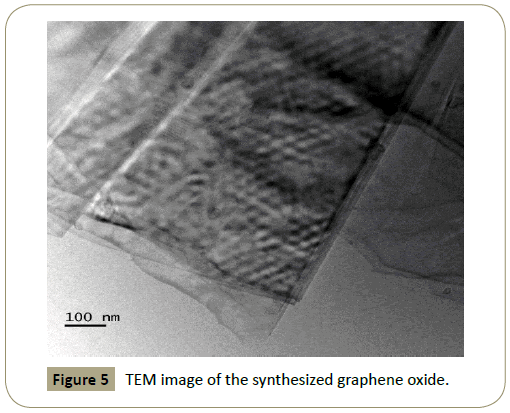
Figure 5: TEM image of the synthesized graphene oxide.
Characteristics of Ni-W-GO composite coating
SEM study: The surface appearance of the alloy and composite coatings were examined using SEM and the obtained images are shown in Figure 6. The alloy coating was found to be almost flat with full of micro-cracks on the surface [17]. Whereas, the composite coating was observed to have homogeneous nodular growths along with the micro-cracks on the surface. The variation in surface appearance of the composite coating compared with the optimal alloy coating is attributed to the incorporation of GO nanosheets into the alloy matrix. Further, the change in surface morphology of the composite coating is ascribed to the increase in W content in the coating effected from the addition of GO into the plating bath. The increase in W content is evident from the EDS analysis results as tabulated in Table 1. The micro-cracks on the alloy and composite coatings are attributed to the hydrogen embrittlement and also due to the inherent brittle nature of W [17,21].
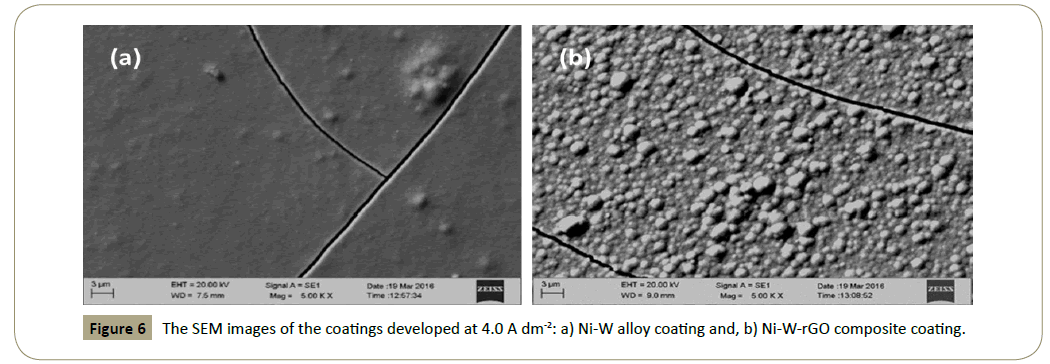
Figure 6: The SEM images of the coatings developed at 4.0 A dm-2: a) Ni-W alloy coating and, b) Ni-W-rGO composite coating.
| Coatings developed at 4.0 A dm-2 |
Wt.% of W in the deposit |
Wt.% of C in the deposit |
Thickness of the coating (μm) |
Vicker’s microhardness V100
(GPa) |
Nature of the deposit |
| Ni-W-rGO composite coating |
22.4 |
3.1 |
16.1 |
3.91 |
Bright |
| Ni-W alloy coating |
12.4 |
--- |
15.9 |
3.22 |
Bright |
Table 1: The properties of the alloy and composite coating developed from the same bath under optimal conditions.
XRD analysis: The phase structure of the alloy and composite coatings were analyzed using XRD technique and the obtained XRD pattern are given in Figure 7. The distinct variation in reflections of composite coating the alloy coatings confirms the variation in composition and thereby the variation in the crystal structure of the composite obtained after the incorporation of GO into the alloy matrix. The direction of crystal growth in the composite coating was observed to be changed to W rich (220) plane than the (111) plane in the alloy [17,21]. Further, there was a small shift in the positions of main peak reflections of the composite coating compared with the alloy coating [17]. This shift in peak positions is attributed to the incorporation of GO and thereby the increased W content in the composite coating as compared with alloy coating. The refinement in grain size leading to the formation of nodular growths on the composite surface is also evident from the peak broadening effect, observed in the composite coating [18,20,22]. The presence of (002) peak at 2θ=26.4˚ confirms that the GO is deposited as reduced graphene nanosheets into the alloy matrix [11,14,20]. Further, the W rich composite coating resulted in the formation of new reflections corresponds to the W rich phases. It may also note that the intensity of the peaks present in the alloy coating was found to be decreased or disappeared in the composite coating along with the formation of new reflections.
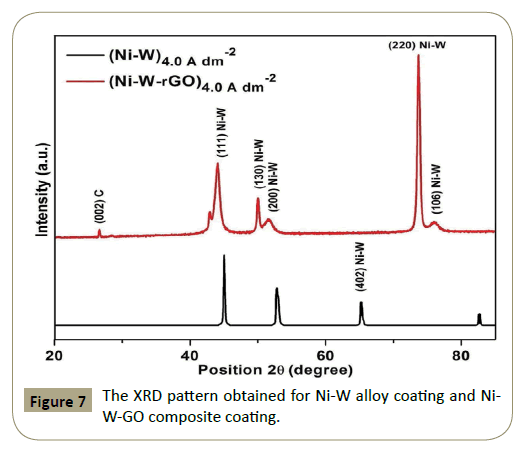
Figure 7: The XRD pattern obtained for Ni-W alloy coating and Ni- W-GO composite coating.
Effect of GO on coating properties
The addition of GO into the plating bath was found to influence the coating properties to a greater extent. The composite electrodeposition leading to the formation of Ni-W-GO nanocomposite coating was found to be effective in enhancing the W content in the coating. The codeposition of the GO as rGO nanosheets along with the metal ions increased the effective surface area for deposition and thereby triggered the enhanced deposition also onto the surface of incorporated graphene nanosheets [23,24]. This type of enhanced deposition activated by the reduced graphene sheets intersticed in the alloy matrix resulted in the formation of W rich composite coating. The effect of incorporated rGO on the coating properties such as composition, thickness, microhardness and appearance are given in Table 1. The alloy and composite coatings were found to be bright in visual observation. The thickness and microhardness of the composite coating were also found to be increased in the composite coating with an increase in W content in the coating.
Electrocatalytic activity for alkaline hydrogen production
Cyclic voltammetry analysis: The activity of the alloy and composite test electrodes towards alkaline HER was studied using CV analysis. The current-voltage responses obtained from the CV analysis for alloy and composite coatings are shown in Figure 8. The remarkable variation in cathodic peak current density (ipc) and onset potential obtained for composite coating suggests the enhancement in HER activity after the incorporation of reduced graphene oxide nanosheets. The Ni-W-rGO composite coating was observed to have the maximum current response with minimum onset potential for H2 as the data given in Table 2. The increase in ipc value from -0.66 A cm-2 for alloy to -0.83 A cm-2 for Ni-W-rGO confirms the improvement in HER activity [25-28]. At the same time, the onset potential was also found to become nobler in the composite coating (-1.03 V) as compared with the alloy coating (-1.21 V).
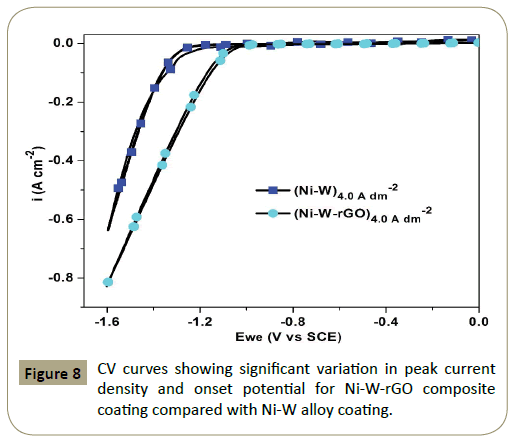
Figure 8: CV curves showing significant variation in peak current density and onset potential for Ni-W-rGO composite coating compared with Ni-W alloy coating.
Chronopotentiometry analysis: The robustness of the alloy and composite test electrodes for alkaline HER was studied using CP analysis by applying a constant current density of -300 mA cm-2, for 1800 s. The amount of hydrogen evolved during the first 300 s of analysis from each test electrodes were quantified to relate the efficiency in terms of practical activity. The obtained CP curves and the amount of H2 evolved from each test electrodes are given in Figure 9.
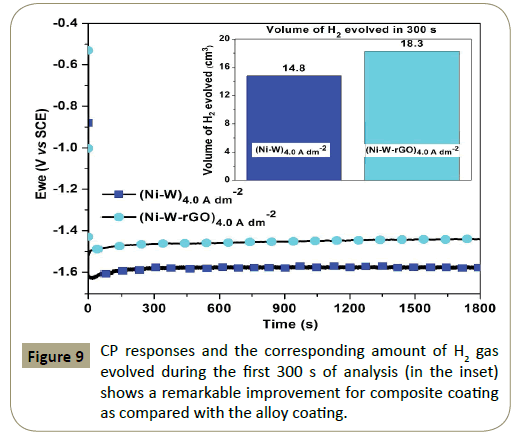
Figure 9: CP responses and the corresponding amount of H2 gas evolved during the first 300 s of analysis (in the inset) shows a remarkable improvement for composite coating as compared with the alloy coating.
The CP response of the composite coating shows a significant variation in terms of both potential and volume of H2 gas evolved during the analysis. The observed results suggest the composite coating as an efficient electrode material for alkaline hydrogen production as compared with the alloy coating. The corresponding parameters obtained for alkaline HER from CV and CP analysis are given in Table 2. The robustness of the composite electrode under the alkaline water splitting condition is evident from the obtained stable curve and the continuous evolution of hydrogen. The enhancement in electrocatalytic efficiency of the Ni-W-rGO composite coating may be attributed to the increased W content in the composite coating along with the increased surface area [12,24,26,28]. The deposition of the added GO as rGO by reduction during the electrodeposition process, as evident from the (002) peak in the XRD analysis (Figure 7), is ascribed to the increased surface area of the composite coating [11,14]. The influence of this deposited rGO on the induced codeposition of reluctant metal ‘W’, leading to the variation in composition, crystallographic orientation, surface morphology and thereby the electrocatalytic activity of the composite coating [12]. The W content in the Ni-W-rGO composite coating used in the present study is 22.4%. The Ni-W alloy having still higher wt. % of W is found to exhibit increased corrosion resistance [29] and electrocatalytic activity [21]. Hence, the observed drastic increase of H2 evolution on Ni-W-rGO composite coating is the combined effect of both increased W content and increased surface area due to rGO incorporation [21,26,28].
| Coating developed at 4.0 A dm-2 |
Cathodic peak c.d.
(A cm-2) |
Onset potential for H2 evolution
(V vs SCE) |
Volume of H2 evolved in 300 s
(cm3) |
| Ni-W-rGO composite coating |
-0.83 |
-1.03 |
18.3 |
| Ni-W alloy coating |
-0.66 |
-1.21 |
14.8 |
Table 2: The alkaline hydrogen evolution parameters of Ni-W alloy and Ni-W-rGO composite coating obtained from CV and CP analysis.
References
- Ball M, Wietschel M (2009) The future of hydrogen-opportunities and challenges. Int. J. Hydrogen Energy. 34: 615-627.
- Holladay JD, Hu J, King DL, Wang Y (2009) An overview of hydrogen production technologies. Catal. Today. 139: 244-260.
- LeRoy RL (1983) Industrial water electrolysis: present and future. International Journal of Hydrogen Energy. 8: 401-417.
- Zou X, Zhang Y (2015) Noble metal-free hydrogen evolution catalysts for water splitting. Chem. Soc. Rev. 44: 5148-5180.
- Tilak BV, Ramamurthy AC, Conway BE (1986) High performance electrode materials for the hydrogen evolution reaction from alkaline media. Proc. Indian Acad. Sci. (Chem. Sci.) 97: 359-393.
- Cardoso DSP, Amaral L, Santos DMF, Šljukić B, Sequeira CAC, et al. (2015) Enhancement of hydrogen evolution in alkaline water electrolysis by using nickel-rare earth alloys. Int. J. Hydrogen Energy 40: 4295-4302.
- Ahmad YH, Mohamed AM (2014) Electrodeposition of nanostructured nickel-ceramic composite coatings: a review. Int. J. Electrochem. Sci. 9: 1942-1963.
- Szeptycka B, Gajewska-Midzialek A, Babul T (2016) Electrodeposition and Corrosion Resistance of Ni-Graphene Composite Coatings. J. Mater. Eng. Perform. Pp: 1-5.
- Gyftou P, Pavlatou EA, Spyrellis N (2008) Effect of pulse electrodeposition parameters on the properties of Ni/nano-SiC composites. Appl. Surf. Sci. 254: 5910-5916.
- Gan YX (2012) Structural assessment of nanocomposites. Micron. 43: 782-817.
- Kuang D, Xu L, Liu L, Hu W, Wu Y (2013) Graphene-nickel composites. Appl. Surf. Sci. 273: 484-490.
- Badrayyana S, Bhat DK, Shenoy S, Ullal Y, Hegde AC (2015) Novel Fe-Ni-graphene composite electrode for hydrogen production. Int. J. Hydrogen Energy. 40: 10453-10462.
- Huang Y, Fan H, Chen Z, Gu C, Sun M, et al. (2016) The effect of graphene for the hydrogen evolution reaction in alkaline medium. Int. J. Hydrogen Energy. 41: 3786-3793.
- Chen L, Tang Y, Wang K, Liu C, Luo S (2011) Direct electrodeposition of reduced graphene oxide on glassy carbon electrode and its electrochemical application. Electrochem. Commun. 13: 133-137.
- Hilder M, Winther-Jensen B, Li D, Forsyth M, MacFarlane DR (2011) Direct electro-deposition of graphene from aqueous suspensions. PCCP 13: 9187-9193.
- Elias L, Hegde AC (2015) Electrodeposition of laminar coatings of Ni-W alloy and their corrosion behavior. Surf. Coat. Technol. 283: 61-69.
- Elias L, Scott K, Hegde AC (2015) Electrolytic Synthesis and Characterization of Electrocatalytic Ni-W Alloy. J. Mater. Eng. Perform. 24: 4182-4191.
- Su X, Wang G, Li W, Bai J, Wang H (2013) A simple method for preparing graphene nano-sheets at low temperature. Adv. Powder Technol. 24: 317-323.
- Allahbakhsh A, Sharif F, Mazinani S, Kalaee MR (2014) Synthesis and characterization of Graphene Oxide in suspension and powder forms by chemical exfoliation method. Int. J. Nano Dimension. 5: 11.
- Kumar CP, Venkatesha TV, Shabadi R (2013) Preparation and corrosion behavior of Ni and Ni-graphene composite coatings. Mater. Res. Bull. 48: 1477-1483.
- Elias L, Cao P, Hegde AC (2016) Magnetoelectrodeposition of Ni-W alloy coatings for enhanced hydrogen evolution reaction. RSC Adv. 6: 111358-111365.
- Cargill GS (1970) Structural Investigation of Noncrystalline Nickel-Phosphorus Alloys. J. Appl. Phys. 41: 12-29.
- Liu C, Wang K, Luo S, Tang Y, Chen L (2011) Direct Electrodeposition of Graphene Enabling the One-Step Synthesis of Graphene-Metal Nanocomposite Films. Small. 7: 1203-1206.
- Wang M, Wang Z, Gong X, Z Guo (2014) The intensification technologies to water electrolysis for hydrogen production-A review. Renewable Sustainable Energy Rev. 29: 573-588.
- Shen M, Bennett N, Ding Y, Scott K (2011) A concise model for evaluating water electrolysis. Int. J. Hydrogen Energy. 36: 14335-14341.
- Elias L, Hegde AC (2016) Modification of Ni-P alloy coatings for better hydrogen production by electrochemical dissolution and TiO2 nanoparticles. RSC Adv. 6: 66204-66214.
- Zeng K, Zhang D (2010) Recent progress in alkaline water electrolysis for hydrogen production and applications. Prog. Energy Combust. Sci. 36: 307-326.
- Elias L, Hegde AC (2016) Synthesis and characterization of Ni-P-Ag composite coating as efficient electrocatalyst for alkaline hydrogen evolution reaction. Electrochim. Acta. 219: 377-385.
- Elias L, Hegde AC (2017) Effect of magnetic field on corrosion protection efficacy of Ni-W alloy coatings. Journal of Alloys and Compounds. 712: 618-626.










